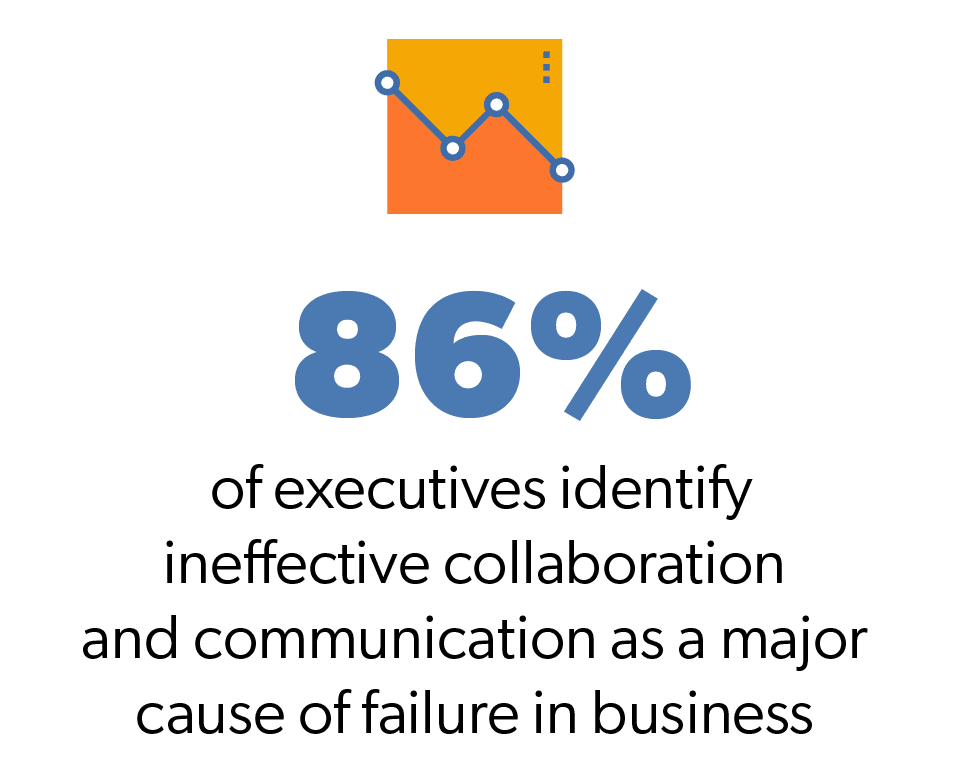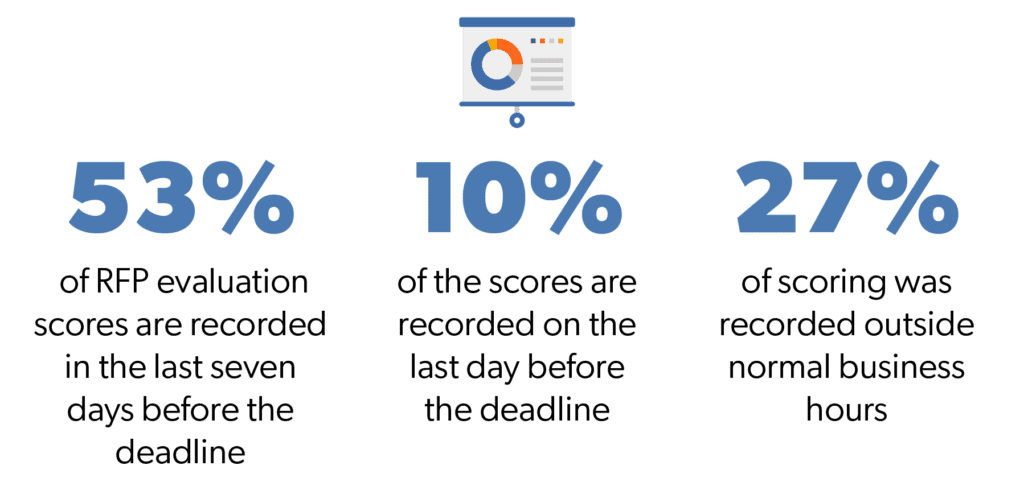Organizations resist investing in new technology for many reasons — concerns about ROI, not wanting to disturb workflow, maintaining current processes — the list goes on. But in the age of digital transformation, each day of delay is a day your business is potentially falling behind the competition. So, it’s important to ask — what could your organization be losing as a result? What is the real cost of an inefficient RFP process? The same conversations happen when examining the RFP process.
Organizations delay investing in new RFP software for a lot of reasons, maybe legacy systems are doing an adequate job or perhaps there’s a belief that manual RFP work and analog processes are saving the company money. But, when you consider the speed of technology, you may not be saving as much money as you think. But, how much are organizations really losing relying on an old, inefficient RFP process? Let’s explore.
Inefficiency in the workplace: The big picture
Inefficiency is often rooted in a simple problem: employees that are poorly equipped or lacking the tools it takes to do the job. In fact, 75 percent of American workers don’t believe they have access to the latest efficiency-boosting technology.
Interruptions are also a key cause of lost productivity. If you’ve been on the receiving end of a few too many pings, alerts and notifications today, you’re not the only one. As G2 reports,
“The average employee is interrupted from their work 56 times a day. The average employee spends two hours a day recovering from interruptions.”
Also contributing to the widespread workplace inefficiency crisis: workloads that are too full. Even when your organization has a team of dedicated, driven, high-capacity professionals, prioritizing and managing too many projects and responsibilities is an overwhelming and costly struggle. As Dynamic Signal explains, work overload decreases productivity by 68 percent in employees who feel they don’t have enough hours in the day to complete their tasks.
https://rfp360.com/wp-content/uploads/2019/09/Cost-of-inefficiency-new.png
4 ways RFP software cures your inefficient RFP process
Like the grand-scale problem of workplace inefficiency, your organization may also be losing revenue by not implementing time-saving RFP software.
Think about how your organization navigates the RFP process today. Sending Word and Excel files emailed back and forth? Maintaining binders and file folders? Managing cumbersome email chains? 84% of organizations still use an inefficient RFP process to manage their RFP responses. This waste adds up and helps to prove the real value of RFP software and the true cost of not having the right RFP tool for your team.
Without RFP software, a company limits the collaborative potential of its team. From early-stage startups to the largest and oldest corporations, it’s tough to find a leadership team that doesn’t believe in collaboration. Collaboration is key to innovation and fuel for growth. But the vast majority of collaboration is being led by just a handful of team members. As the Harvard Business Review explains,
“Research we’ve done across more than 300 organizations shows that the distribution of collaborative work is often extremely lopsided. In most cases, 20% to 35% of value-added collaborations come from only 3% to 5% of employees.”
We all know the “extra milers” in our workplaces: those who go above and beyond, frequently contributing beyond the scope of their job descriptions, time and time again. Research shows that just one of these generous collaborators can drive team performance more than all the other members combined. Talk about ROI!
That’s fantastic news for those who constantly go above and beyond. But if it’s just 5 percent of team members offering about a third of value-added collaboration — then what does that mean for the other 95 percent? The vast majority of team members are underutilized at best, and disengaged at worst. It’s inefficient, and a huge missed opportunity. Capitalizing on the collective knowledge and creativity of team members can elevate and transform an organization.
Effective RFPs call for significant collaboration among many stakeholders. But harnessing the power of the group can be a challenge, especially when you’re juggling multiple manual tools, like Word or Excel, or hard copy documents, folders and binders in an inefficient RFP process. RFP software empowers users to work together from anywhere. Version-control challenges (wait, are we working from V4 or V5 now?) are a thing of the past.
Remember the old game of telephone we played as kids? The first person started with a sentence and whispered it to the second. By the time the message got down to the final kid, nothing made sense. No matter how well it was articulated to start with.
Sometimes, we play our own game of grown-up telephone in our workplaces. If you’ve faced this problem in your organization, you’re certainly not alone. Poor communication is an expensive challenge, as the Mitchell Communications Group reports,
“Miscommunication costs businesses $37 billion (or $26,000 per employee) in the U.S. and the U.K. every year.”
This problem is more than an inconsistency here and there, 86% of executives identify ineffective collaboration and communication as a major cause of failure in business.

Without collaborative RFP software, the chances of miscommunication spike. RFP software acts as a communication anchor, so all collaborators are working together and staying on the same page. No more messages buried in inboxes or hiccups around version control. Let’s face it, we’d all be happier if we never had to ask a colleague to send over the most updated document again.
Automation is awesome. In your personal life, you likely are already automating boring, routine tasks without even realizing it. Everyday automation like paying bills, adjusting the thermostat and even vacuuming gives you more free time to spend doing whatever you want. So why not use RFP process automation as well?
Researchers at Salesforce and the McKinsey Global Institute report that 40 percent of tasks within the traditional sales function can now be automated. So without RFP software, you may be overlooking huge opportunities for automation. Automating an inefficient RFP process frees your team up to do the truly strategic work that can move your organization forward.
This challenge becomes even more painful when viewed through the lens of administration. Of sales teams, 45 percent report excessive administration duties like manual entry as one of their main challenges. If your company is leaning too hard on manual administration, there’s a higher risk of human error, inefficiency and just plain exhaustion. Doing excessive manual, analog work, in areas where digital tools can help, holds your team back.
No one wants to admit it — but we’re all guilty of procrastinating once in awhile. The stats show that 53 percent of RFP evaluation scores are recorded in the last seven days before the deadline, and 10 percent of the scores are recorded on the last day before the deadline. In addition, 27 percent of scoring was recorded outside normal business hours. It’s another indicator of how much work overload may be costing your organization.

Antiquated, legacy RFP systems — in part because of their cumbersome nature — lend themselves to procrastination. It’s human nature to leave the least exciting tasks for last.
In a similar sense, organizations can trim the time spent on “reinventing the wheel” when it comes to RFPs. Organizations are losing money and time when team members are tracking down the same answer details, seeking information from the same colleagues and searching for the same content, time after time. As McKinsey Global Institute reports,
“Workers spend nearly 20 percent of their time looking for internal information or tracking down colleagues who can help with specific tasks. A searchable record of knowledge can reduce, by as much as 35 percent, the time employees spend searching for company information.”
Without an RFP solution, team members spend valuable time searching for the right information.
“Workers spent up to 25 minutes looking for a single document in over a third of searches conducted. In 80 percent of cases, it took up to eight attempts to find the right information.”
RFP software makes it easy to reusing past proposal content. By saving responses, organizations mitigate the risk by retaining institutional knowledge, improving accuracy and ensuring consistency. Adopting technology to manage response knowledge means you won’t lose expertise as a result of personnel shifts.
Investing in an RFP process improvement solution
The numbers tell the larger story: workplace inefficiency is a pricey problem. And while organizations may think they are saving money when they steer clear of new solutions, the very opposite may be true. There’s a big price tag when organizations choose inefficiency.
Improve awareness to improve productivity
Improving productivity, at the core, starts with awareness. First, how does your organization define value? And then, what tools do you need to provide to empower and equip your team? As the Harvard Business Journal advises,
“To really improve productivity — and to be honest about what it means — you first have to gain a level of organizational self-awareness to understand what work actually drives value at your company, and then direct employees towards these tasks.”
Organizational change
Shifting the organizational perspective is also a game-changer, as the Harvard Business Journal continues,
“To be clear, individual productivity is often a worthy goal. But leaders also need to stop thinking about productivity at an individual — or even team — level. It’s time to start shifting to an organizational mindset and set of tools that can provide full visibility into what work is actually getting done in aggregate, and where it does (or does not) create value, how ever you define it.
Holistic software investments
Thinking holistically as you make investments in software is critical.
“The ultimate — albeit difficult-to-achieve — goal is a large organization in which all knowledge workers have full context, tools, and support to focus their time on the biggest value drivers of the business without being bogged down by overhead and bureaucracy. That’s exciting not only for the actual productivity gains that will result at an organizational level, but also for each employee who will finally have a clear sense of what matters and how to be successful. A company will know that they’ve achieved this state when personal productivity gains actually do add up to enterprise ones.”
Request a free demo to see first-hand how RFP360 can improve your inefficient RFP process.
